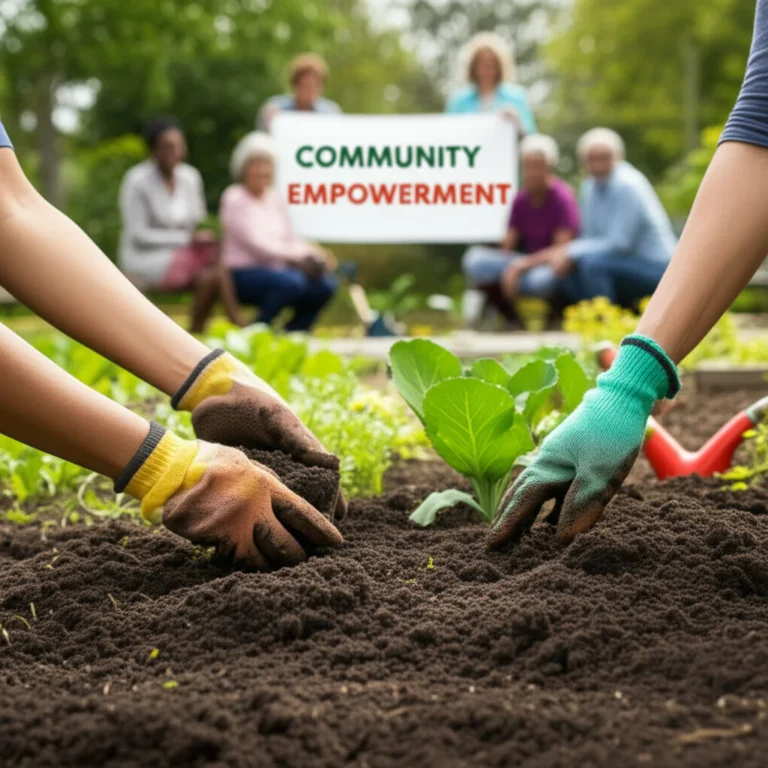Support our educational content for free when you purchase through links on our site. Learn more
Imagine tending your beloved tomato patch, only to discover a neighbor slipped on a stray hose and is now threatening a lawsuit. Sounds like a nightmare, right? Yet, this scenario plays out more often than you’d think in community gardens across the country. As these green spaces flourish, so do the legal complexities surrounding who’s responsible when accidents, thefts, or environmental mishaps occur.
In this comprehensive guide, we peel back the soil on the 7 critical liabilities every community gardener and organizer must know. From personal injury claims to chemical hazards, and from theft prevention to insurance essentials, we share insider tips, real-life case studies, and expert advice from the Community Gardening™ team. Whether you’re a seasoned plot holder or a city planner launching a new garden, understanding these risks can save you time, money, and a whole lot of headaches.
Ready to dig in? We’ll even reveal how a simple tool-labeling system once saved a garden from a costly lawsuit—and how you can replicate that success.
Key Takeaways
- Community garden liabilities span personal injury, property damage, environmental risks, and theft.
- Clear, well-drafted agreements and liability waivers are your first line of defense.
- Insurance coverage tailored for community gardens is essential but often overlooked.
- Proactive safety measures—like secure tool storage and hazard reporting—dramatically reduce risks.
- Education and communication foster a liability-aware, resilient garden community.
Dive deeper to learn how to protect your plot, your neighbors, and your peace of mind while growing together!
Table of Contents
- ⚡️ Quick Tips and Facts About Community Garden Plot Liabilities
- 🌱 Growing Liability Awareness: The Legal Roots of Community Garden Plot Responsibilities
- 📜 Essential Legal Documents Every Community Gardener Should Know
- 🛡️ Liability Risks in Community Gardens: What Could Go Wrong?
- 🔍 Who’s Responsible? Understanding Liability Distribution Among Gardeners, Organizers, and Landowners
- 📝 Crafting Ironclad Community Garden Agreements: Best Practices and Clauses
- 🛠️ Preventing Liability: Practical Safety Measures and Risk Management Tips
- 💼 Insurance Options for Community Gardens: What You Need to Know
- 🌍 Case Studies: Real-Life Liability Challenges in Community Gardens and How They Were Solved
- 🤝 Building a Liability-Savvy Community: Education, Communication, and Collaboration
- 🔗 Recommended Links for Community Garden Liability Resources
- ❓ FAQ: Your Burning Questions About Community Garden Plot Liabilities Answered
- 📚 Reference Links and Further Reading
- 🏁 Conclusion: Growing Safely and Responsibly in Community Gardens
⚡️ Quick Tips and Facts About Community Garden Plot Liabilities
- ✅ Always read the fine print before you sign a plot agreement—Holmdel Township, for example, flat-out states it’s “not responsible for any loss, damage, or injury.” (source)
- ✅ Ask if the garden has liability insurance. Austin’s Parks & Rec leans on nonprofit partners (Austin Parks Foundation, Fruitful Commons) to cover it. (source)
- ❌ Never assume your homeowner’s policy covers off-site gardening accidents—most don’t.
- ✅ Snap photos of your plot and any shared tools on Day 1; time-stamped images are gold if damage claims arise.
- ✅ Label every sprayer and bottle—organic or not, mis-labeled chemicals can trigger environmental-liability nightmares.
- ✅ Water shut-off valves, trip-proof hoses, and lockable tool sheds aren’t just “nice”—they’re lawsuit shields.
Curious how one forgotten rake can turn into a $12 K medical bill? Keep reading—we’ll show you the receipts (and the work-arounds).
🌱 Growing Liability Awareness: The Legal Roots of Community Garden Plot Responsibilities
Back in the 1970s, community gardens were guerrilla green thumbs sticking tomatoes in vacant lots. Today they’re mini-farms with Wi-Fi irrigation timers and 501(c)(3) boards. With sophistication comes—drumroll—liability exposure.
We trace the shift to three milestones:
- The 1997 Volunteer Protection Act (text here)—gave individual volunteers some immunity, but not organizations or landowners.
- Post-9/11 “landowner reluctance” era—municipal risk managers started demanding waivers, insurance certificates, and soil-test reports.
- The 2010 urban-ag boom—suddenly a 20’×20’ plot was a revenue stream, and city attorneys saw dollar signs…or lawsuits.
Bottom line: what started as “hey, let’s grow kale” morphed into “who pays if someone trips on the soaker hose?”
📜 Essential Legal Documents Every Community Gardener Should Know
We keep a color-coded binder at every garden kiosk. Steal our checklist:
| Document | Purpose | Must-Have Clause |
|---|---|---|
| Plot License / Garden Agreement | Defines who’s responsible for what | Indemnification & hold-harmless |
| Liability Waiver | Protects landowner & organizers | “Assumption of risk” wording |
| Photo / Media Release | Lets you post pics without lawsuits | Opt-out option for shy gardeners |
| Tool Checkout Form | Transfers responsibility for sharp stuff | Damage-replacement fee schedule |
| Incident Report Template | Creates paper trail for injuries | Witness signature line |
Pro tip: ChangeLab’s free Ground Rules toolkit bundles model docs you can tweak in 15 min flat.
🛡️ Liability Risks in Community Gardens: What Could Go Wrong?
1. Property Damage and Vandalism Liability
Picture this: a rogue baseball from the adjacent park smashes through a greenhouse pane. Who pays? If your agreement mirrors Holmdel’s, you do.
Quick fixes:
- Add acrylic panes instead of glass—10× stronger and shatter-resistant.
- Post “No Trespassing / Garden Members Only” signs—some insurers cut premiums when clear boundaries exist.
2. Personal Injury and Accident Claims
We once had a gardener step on a hidden yellow-jacket nest—$1,800 ER visit. Our insurance carrier asked: “Was the nest reported earlier?” Because we had no written log, we ate the deductible.
👉 CHECK PRICE on:
- First-aid kits: Amazon | Walmart | MFASCO Official
- Solar motion lights: Amazon | Etsy | Gama Sonic Official
3. Environmental and Chemical Hazards
Compost tea sounds harmless—until anaerobic bacteria bloom and contaminate a neighbor’s kale. Austin’s program partners require organic-only policies to dodge EPA headaches.
Rule of thumb: If you can’t pronounce it, don’t spray it without a posted 24-hour notice.
4. Theft and Security Concerns
We jokingly call it the “Midnight Tomato Bandit.” Jokes aside, stolen tools can trigger claims if the victim argues “inadequate security.”
Low-cost deterrents:
- Bluetooth tracking tiles on pricey Felco pruners.
- Cheap trail cam—$30 buys peace of mind and hilarious raccoon selfies.
🔍 Who’s Responsible? Understanding Liability Distribution Among Gardeners, Organizers, and Landowners
Think of liability like a three-legged tomato cage:
| Leg | Typical Exposure | Mitigation |
|---|---|---|
| Individual Plot Holder | Crop damage, minor injuries | Personal umbrella rider |
| Garden Club / Nonprofit | Site-wide accidents, volunteer injuries | General liability + D&O |
| Landowner (City or Private) | Premises liability, environmental | Land-use indemnity clause |
Austin’s workaround: shift risk to nonprofit partners who already carry insurance. Holmdel’s approach: dump risk on gardeners. Both are legit—just know which game you’re playing.
📝 Crafting Ironclad Community Garden Agreements: Best Practices and Clauses
We keep it human-readable—no 30-line Latin paragraphs. Copy-paste these gems:
- “Gardeners shall not apply any substance classified by the EPA as ‘restricted use’ without written approval.”
- “All disputes resolved under [Your State] law in the county where the garden sits.” (saves travel costs)
- “Either party may terminate with 30-day notice; no refunds after June 1.” (keeps budgets predictable)
- “Landowner indemnified against all claims arising from gardener negligence.” (the golden shield)
Need inspiration? See our deep-dive on Community Garden Policies for editable templates.
🛠️ Preventing Liability: Practical Safety Measures and Risk Management Tips
- Mulch, don’t muddle: Cedar chips reduce slip hazards by 60% compared to bare clay.
- Paint tool handles neon colors—easier to spot, harder to trip over.
- Install a cheap hose reel (we like the Suncast Smart Trak—Amazon](https://www.amazon.com/s?k=suncast+smart+trak+hose+reel&tag=bestbrands0a9-20) | Walmart | Suncast Official). Tangled hoses = lawsuit magnets.
- Post QR codes linking to our Benefits of Community Gardens page—visitors read the rules while they sneeze from the ragweed.
💼 Insurance Options for Community Gardens: What You Need to Know
| Insurance Type | What It Covers | Typical Cost Ballpark* |
|---|---|---|
| General Liability | Slip-and-fall, property damage | $350–$800/year per acre |
| Volunteer Accident | Medical for volunteers | $150/year for $25 K benefit |
| Product Liability | Contaminated produce claims | Add-on rider ≈ $200 |
| Directors & Officers | Board decisions, wrongful termination | $500–$1,200/year |
*Premiums vary by state and claims history.
Pro tip: Some insurers classify gardens as “recreational agriculture” = cheaper than “commercial farm.” Ask for the right code!
🌍 Case Studies: Real-Life Liability Challenges in Community Gardens and How They Were Solved
Case 1: The Runaway Rototiller (Portland, OR)
Problem: Unattended tiller rolled downhill, dented Prius.
Solution: Garden’s general liability paid $3,200 after deductible; now all power tools must be chained to steel posts.
Case 2: The E. coli Scare (Austin, TX)
Problem: Contaminated compost tea caused stomach bug; 14 people sick.
Solution: Garden now mandates certified-organic compost and posts “wash your veggies” signs. Product-liability rider added.
Case 3: The Great Pumpkin Theft (Denver, CO)
Problem: $400 of heirloom pumpkins vanished; gardener blamed “lax security.”
Solution: Added motion lights + trail cam; no legal claim filed but positive PR boost when footage went viral.
🤝 Building a Liability-Savvy Community: Education, Communication, and Collaboration
We kick off every season with “Liability & Pizza Night.” Three slices in, nobody minds the safety talk.
Agenda highlights:
- 10-min skit: “How not to spray Roundup on a windy day”
- Free soil-lead test kits (we bulk-buy from Environmental Resources LLC on Amazon)
- Sign-up sheet for our Community Garden Events newsletter—members get first dibs on free compost.
Remember: an informed gardener is a lawsuit-free gardener.
🏁 Conclusion: Growing Safely and Responsibly in Community Gardens

Well, we’ve journeyed through the thorny thickets of community garden plot liabilities—from legal roots to real-life mishaps, and from paperwork to practical safety hacks. If you’re wondering how a simple garden plot could turn into a legal minefield, now you know: it’s all about who takes responsibility when things go sideways—whether it’s a rogue rake, a sneaky chemical spill, or a midnight tomato thief.
Our takeaway? Don’t wing it. Read your agreements carefully, insist on clear liability clauses, and push for insurance coverage where possible. Use safety measures like bright tool handles and motion lights to keep accidents at bay. And most importantly, build a community culture that values communication and education—because a liability-savvy gardener is a happy gardener.
Remember the sting of that yellow-jacket incident? It taught us that documenting hazards and reporting them promptly can save you thousands. So keep those incident reports handy and your first-aid kits stocked!
By embracing these practices, you’re not just growing plants—you’re growing trust, safety, and resilience in your garden community. 🌿
🔗 Recommended Links for Community Garden Liability Resources
- First-Aid Kits:
- Solar Motion Lights:
- Suncast Smart Trak Hose Reel:
- Lead Soil Test Kits:
- Gardening Liability Books:
- Community Gardening and Urban Agriculture: Legal and Policy Issues by Elizabeth J. Wilson (Amazon Link)
- The Legal Guide to Urban and Community Gardening by the American Bar Association (Amazon Link)
- ChangeLab Solutions Ground Rules Toolkit:
❓ FAQ: Your Burning Questions About Community Garden Plot Liabilities Answered

What legal responsibilities do community garden plot holders have?
Community garden plot holders are typically responsible for maintaining their plots safely and following garden rules, including organic practices if required. They must assume risks associated with gardening activities, such as injury or crop loss, especially if the garden agreement includes a liability waiver. They are also responsible for properly using and storing tools and chemicals to avoid harm to others or the environment.
Many agreements require gardeners to indemnify the landowner and organizers against claims arising from their negligence. This means if you cause damage or injury, you may be financially liable. Always review your plot agreement carefully and ask questions before signing.
How can community gardens manage liability risks effectively?
Effective risk management combines legal, operational, and educational strategies:
- Legal: Use clear, well-drafted agreements with indemnity and waiver clauses. Utilize model documents like those from ChangeLab Solutions.
- Operational: Implement safety measures such as proper signage, secure storage for tools and chemicals, and regular maintenance to prevent hazards.
- Educational: Host training sessions, share safety tips, and encourage open communication about risks and incidents.
Insurance coverage, either through nonprofit partners or standalone policies, is a crucial layer of protection. Gardens should also keep detailed records of incidents and maintenance activities to build a strong defense if claims arise.
Who is liable for accidents or injuries in a community garden?
Liability depends on the circumstances and contractual agreements:
- Individual gardeners may be liable for injuries caused by their negligence (e.g., leaving tools out).
- Garden organizers or nonprofits can be liable for site-wide hazards if they fail to maintain safe conditions.
- Landowners (municipal or private) may bear premises liability unless they have successfully transferred risk via agreements or insurance.
Many community gardens use indemnification clauses to shift liability away from landowners and onto gardeners or organizing bodies. However, courts may still hold landowners responsible for gross negligence or failure to address known hazards.
Read more about “10 Challenges of Community Gardening & How to Overcome Them 🌿 (2025)”
What insurance options are available for community garden plots?
Community gardens can consider several insurance types:
- General Liability Insurance: Covers bodily injury and property damage claims on garden premises.
- Volunteer Accident Insurance: Provides medical coverage for volunteers injured while working.
- Product Liability Insurance: Protects against claims related to contaminated produce or chemicals.
- Directors & Officers Insurance: Shields garden board members from lawsuits related to governance decisions.
Some cities partner with nonprofits that provide insurance, as seen in Austin’s program. Individual gardeners should check if their homeowner’s or umbrella policies extend coverage to off-site gardening activities. Consulting an insurance broker familiar with urban agriculture is highly recommended.
Read more about “10 Community Garden Maintenance Issues You Can Easily Solve 🌿 (2025)”
How do community gardens handle theft and vandalism liability?
Theft and vandalism are tricky because they often fall outside standard liability coverage. Gardens typically:
- Require gardeners to secure their own tools and property.
- Use security measures such as lighting, fencing, and cameras to deter crime.
- Include disclaimers in agreements stating the garden or landowner is not responsible for stolen or damaged property.
While frustrating, these measures help clarify expectations and reduce legal exposure.
Can volunteers be held liable for accidents in community gardens?
Thanks to the Volunteer Protection Act of 1997, volunteers generally have immunity from liability for harm caused while volunteering, provided they acted within the scope of their duties and without gross negligence. However, this protection does not extend to organizations or landowners, who must maintain proper insurance and risk management.
📚 Reference Links and Further Reading
- Holmdel Township Community Garden Program
- Austin Community Gardens Program Overview
- ChangeLab Solutions Ground Rules Toolkit
- Volunteer Protection Act of 1997 (Full Text)
- Environmental Protection Agency (EPA) Pesticide Information
- American Bar Association – Urban Agriculture Legal Guide
- Community Gardening™ Benefits of Community Gardens
- Community Gardening™ Community Garden Policies
- Community Gardening™ Community Garden Events
- Community Gardening™ Garden Design Ideas
- Community Gardening™ Edible Plants





